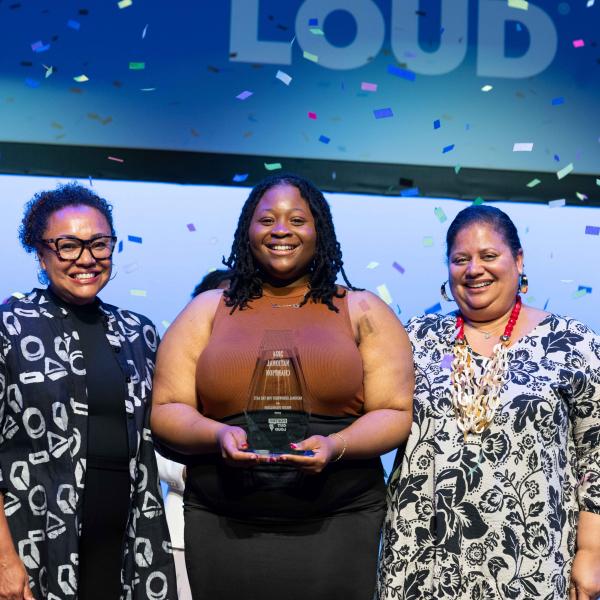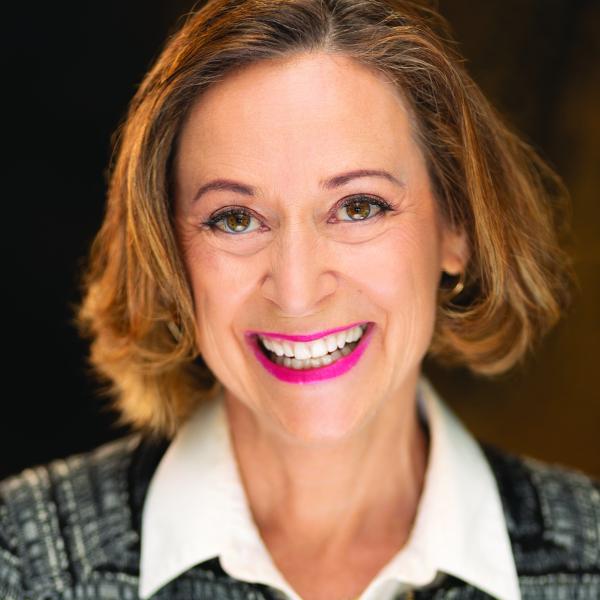Grant Spotlight: The Carr Center
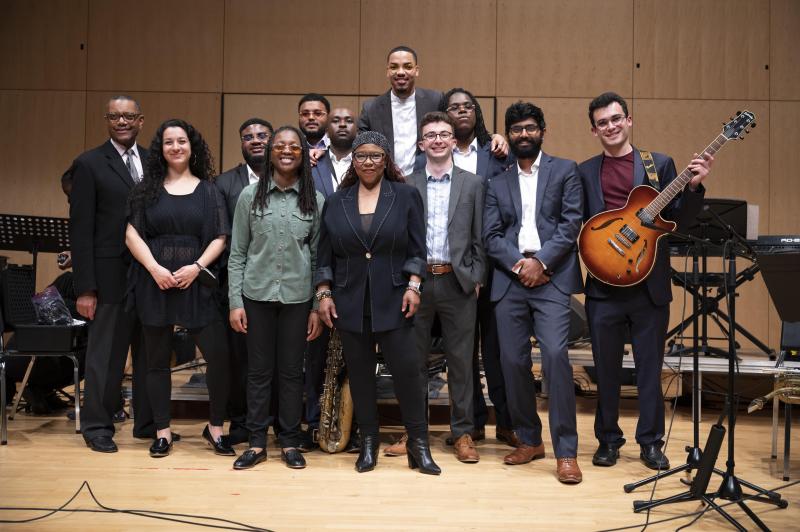
The Gathering Orchestra Nonet and the Carr Center president and CEO Oliver Ragsdale, Jr. (left) basking in the glow after the first public performance of a new work "The Resonate Suite" composed for them by jazz legend Patrice Rushen (pictured center stage with the group). Photo courtesy of Jeff Dunn
Established in 1991 in Detroit, Michigan, the Arts League of Michigan, which operates as the Carr Center, is known for providing cultural arts programming to the community and fostering a creative space for artists to advance their craft and showcase to wider audiences.
Oliver Ragsdale, Jr.—president and CEO of the organization since its inception—stated, “The Carr Center leverages the essence of the African American cultural experience to inspire, entertain, challenge, and educate.” A thread in the fabric of the Detroit community, the Carr Center played a pivotal role in the revitalization of the Paradise Valley Cultural and Entertainment District—generating economic growth for surrounding businesses and creating more job opportunities. Currently located in Detroit’s midtown cultural center, the organization features a visual arts gallery of themed exhibitions and a performance studio, an intimate space for multi-disciplinary artistic programming.
In January 2023, the organization received an Arts Endowment grant to support the work of the Gathering Orchestra Residency, a fellowship and professional development program that pairs early career musicians with veteran performers. Past residencies have included training sessions with the Carr Center artistic director and 2021 NEA Jazz Master Terri Lyne Carrington, 2017 NEA Jazz Master (and former co-artistic director) Dee Dee Bridgewater, Savion Glover, Brandee Younger, and Kris Davis. Expanding the organization’s global reach, the 2021 fellows had the unique opportunity to participate in a virtual cultural exchange program with a jazz ensemble based in Chelyabinsk, Russia.
Ragsdale spoke with us about the Carr Center’s community engagement, the creative process for the Gathering Orchestra Residency, and the importance of keeping jazz music alive for future generations.
NEA: The Carr Center’s organizational mission is “to champion Black cultural arts traditions.” Why do you think jazz music is an essential component in promoting arts and cultural preservation and advancement?
OLIVER RAGSDALE: Jazz is quintessential American music and is among the unique contributions to American and world cultures. Jazz is innovative. The past needs to be preserved while continuing to nurture innovation.
NEA: Fun fact—three of the 2023 NEA Jazz Masters—Regina Carter, Kenny Garrett, and Louis Hayes—are from Detroit, Michigan. How have their musical contributions influenced your organization?
RAGSDALE: We like to say, “there’s something in the Detroit water!” And that water has nurtured generations of incredible musicians. There are 16 NEA Jazz Masters from Detroit and most have a history of nurturing, teaching, mentoring, and giving back. Our programs continue that nurturing—and we serve lots of water!
Regina Carter has been involved with our organization in a number of ways over the years, including as an educator and performing artist. In all of our education programs, the young people learn the history of the music by listening to the masters. All of the education programs advocate the long-term motto of “Each One Teach One.”
NEA: In what ways does the organization engage with the Detroit community?
RAGSDALE: Over the years, the Carr Center has attracted audiences to more than 4,000 events, classes and activities, providing the community with quality experiences in all artistic disciplines. We offer master classes, a variety of arts education programs in the schools, as well as intensive training and mentorship opportunities. Last year our artistic director, Terri Lyne Carrington, curated a Jazz Crawl that involved 13 performances in nine neighborhood cultural institutions. It was a great way to have the community engaged with the music.
We have a program called the Artist Hub where we support artists in the presentation of their work in our space. Over the years, our space has served as a gathering place for the community. One year, we sponsored the creation of a community quilt. The result was 83 unique patches created by community members representing block clubs, churches, families, and organizations. A lot of community pride could be seen in that quilt!
NEA: How has NEA funding helped support the Gathering Orchestra Residency?
RAGSDALE: Fellows receive a stipend, together with support for travel and accommodations while in residence in Detroit. NEA funding will also support other program costs including the residency artistic director Rodney Whitaker, mentors, special commissions, and arrangements for the orchestra together with the fees associated with the master classes and seminars that are a part of each residency.
NEA: What sparked the need to create the residency?
RAGSDALE: The Gathering Orchestra was the vision of the Carr Center’s first artistic director, the phenomenal musician, composer, and jazz educator Geri Allen. She saw the orchestra as a means to institutionalize what had been so important in her early career and what was a Detroit tradition—up and comers playing together with jazz veterans. After Geri’s untimely death, the Carr Center moved forward to achieve her vision. The orchestra is named for one of Geri’s early recordings, with the musicians in the orchestra being named Geri Allen Fellows.
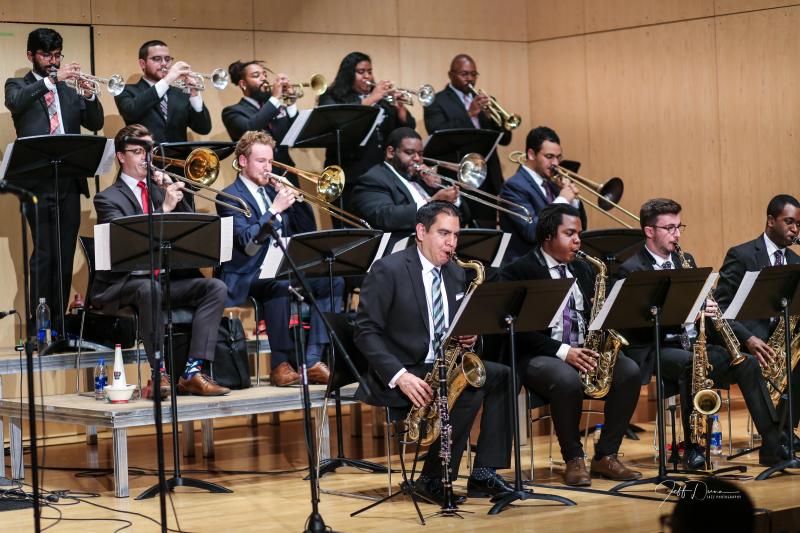
The Gathering Orchestra jamming on stage at the Detroit School of Arts, following a week-long residency. Photo courtesy of Jeff Dunn
NEA: Can you give us a snapshot of the selection process and what the residency entails?
RAGSDALE: The Gathering Orchestra is a 22-piece intergenerational jazz ensemble composed of young professional jazz musicians, chosen through audition, with a veteran mentor for each section of the orchestra. The orchestra is designed to give young professionals the opportunity to hone their “chops” working alongside veteran players and presenting music to the community.
An open call audition process happens every two years. Audition requirements are posted and young musicians submit audition recordings. They are reviewed by the ensemble’s artistic director Rodney Whitaker. We then have a week residency/live audition to make final selections for the two-year residency. Rodney is advised on the final selection by the artists and mentors who will work with and within the ensemble over the residency. They range from a member of Stevie Wonder’s touring ensemble to university faculty and former members of the Jazz at Lincoln Center Orchestra. The artists and mentors bring a wide range of practical experiences that are shared with the ensemble members each day.
For 2023, the orchestra will participate in four week-long residencies in May, June, September, and November. Each residency will include seminars, rehearsals, technical skill training, and a culminating public concert performance. Also, during the week, the orchestra will split into nonets [groups of nine musicians], each engaging in community outreach and arts education in schools and other neighborhood locations. By working in the schools, the Gathering Orchestra Residency exposes youth to jazz music, potentially fostering their interests in the art form as a creative or as a member of the audience. This peer-to-peer model mirrors the Detroit jazz tradition of mentoring.
NEA: What do you wish you could do more of as an organization?
RAGSDALE: Recognizing the dearth of African American presenters, we want to do more to present African American (and of the Diaspora) content within an African American context. We want to create platforms and space, both live and digital, for local emerging artists and internationally renowned artists to have a home for their work. And we want to build multi-cultural audiences that are inspired, educated, challenged, and entertained by Black art in all forms.
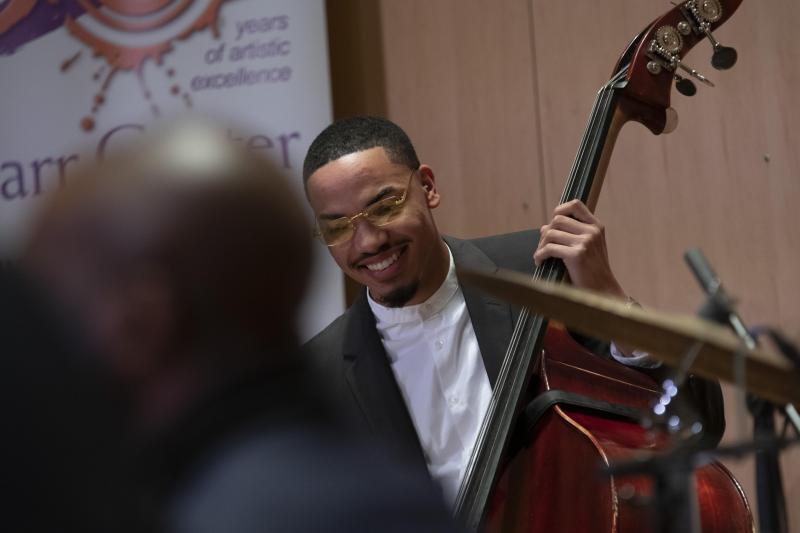
Residency fellow Brandon Rose loving his time on stage with his double bass and the Gathering Orchestra. Photo courtesy of Jeff Dunn
NEA: As a producer and musician, what advice would you give aspiring musicians on what it takes to be a successful artist?
RAGSDALE: As Miss DuPree on the Tom Joyner Morning Show used to say, “Got the gift, got to use it!” I believe we are all given gifts by God. They have to be nurtured, developed, and used in a manner that is for the betterment of mankind. To that end, young musicians have to be committed to the development of their craft. They have to work hard. They have to listen to the music and the people who have already been there. They have to be willing to take risks and to sacrifice. There is nothing easy about this work.
NEA: What are some of the misconceptions about jazz music that you’d like to clear up?
RAGSDALE: Jazz music has been called “the Devil’s music”—not! Working with Terri Lyne Carrington, we want to shift the narrative and build a jazz without patriarchy world. Jazz is for everyone, both artists and audiences. We want the broadest audience possible to listen, learn, enjoy, and share the music. It is not Black music or white music. It is just great music!
NEA: Complete this sentence. Jazz music matters because…
RAGSDALE: As a uniquely American creation, it has become a global cultural signature for the country!


